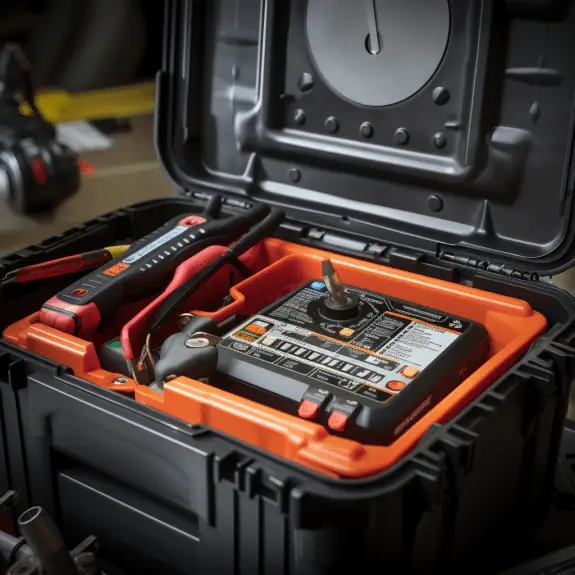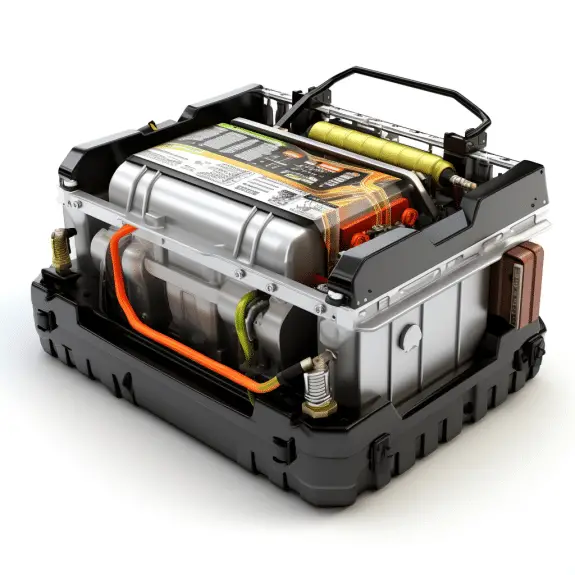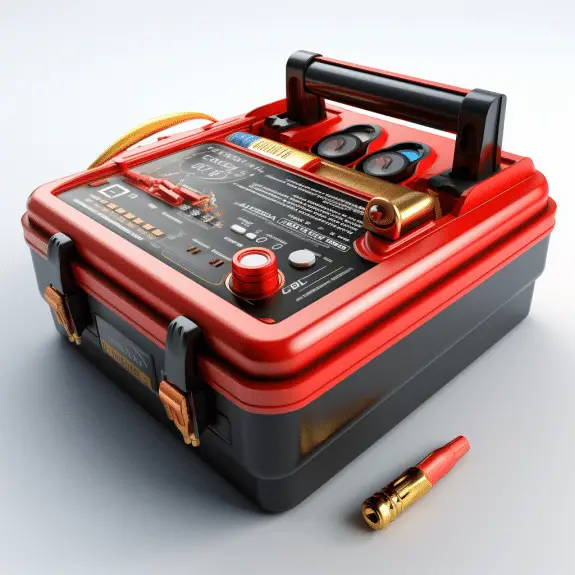
Car Battery CCA Rating: Optimal Performance in Cold Weather
The Car battery CCA rating is about Cold Cranking Amps. This tells how well the battery can start a car in cold weather. The higher the rating, the faster the start-up.
To choose the right battery, you need to understand the CCA rating. It’s calculated by measuring how many amps are delivered at 0°F for 30 seconds with a voltage of 7.2 volts or more.
Different cars need different ratings. Smaller cars usually need 400-600 CCAs. But larger trucks and SUVs require batteries with over 800 CCAs. To be sure, check your owner’s manual or ask a mechanic.
Pro Tip: Don’t get a battery with too high a CCA. It can overwork the electrical system and add weight to the car. Find a battery that has the right balance of CCA and reserve capacity for the best performance.
Explanation of CCA rating
To better understand the CCA rating of a car battery, delve into its explanation. Discover what CCA stands for and why it’s important for car batteries. What does CCA stand for? Importance of CCA rating in car batteries.
What does CCA stand for?
CCA stands for Cold Cranking Amps. It’s a rating used to measure a battery’s ability to start an engine in cold weather. The more CCA a battery has, the easier it is to start the engine. This is important because cold temperatures can reduce a battery’s power.
It measures how much current a battery can give for 30 seconds at 0°F while keeping 7.2 volts or more. So, a higher CCA rating means the battery has enough power to start the engine in cold weather.
The idea of measuring batteries in cold weather started during WW2. Engineers had to come up with ways to check battery performance in extreme conditions. This led to better battery technology over time.
To sum it up, CCA rating is like a battery’s strength in cold weather. Knowing this helps you choose the right battery for your car when it’s freezing outside.
Importance of CCA rating in car batteries
The CCA rating of car batteries is key for steady starting power in cold temperatures. A higher CCA rating shows the battery’s capacity to give out a strong electrical current fast. This is especially relevant during winter when severe cold weather can affect battery performance.
A high CCA rating guarantees that the battery can start the vehicle even in cold conditions. It provides enough juice to start the engine and activate other electrical components. Without an adequate CCA rating, the battery may not be able to give enough current, leading to slow or no starts.
Not only does the CCA rating establish a battery’s ability to start a car, but it also impacts its general performance and life. A higher CCA rating typically indicates a tougher and more durable battery that can handle intense use and longer periods of high electrical demand.
Moreover, car manufacturers usually advise specific CCA ratings for their vehicles depending on engine size and other factors. It is essential to pick a battery with the correct CCA rating to guarantee top performance and compatibility with your car.
Pro Tip: If you usually drive in sub-zero climates or have accessories that draw lots of power from your car’s electrical system, think about investing in a battery with a greater CCA rating than suggested by your vehicle manufacturer. This will give an extra edge of starting power and make sure dependable performance in tough conditions.
Factors influencing CCA rating
To understand the factors influencing the CCA rating of a car battery, delve into battery size and design, as well as temperature considerations. Discover how these elements play a crucial role in determining the performance and reliability of your car battery in cold weather and various driving conditions.
Battery size and design
Let’s analyze how battery size and design can influence CCA rating.
Parameter | Impact on Rating
—————————— | ——————-
Size | Bigger batteries have better CCA ratings due to their higher current delivery capacity.
Plate Thickness | Thicker plates can handle more current, so they have higher CCA ratings.
Number of Plates | More plates mean more power, leading to higher CCA ratings.
Design Optimization | Batteries designed for high performance can have features that boost their CCA rating.
It’s important to remember other factors like temperature and internal resistance also affect battery performance.
The significance of battery size and design on CCA ratings shows the need to choose the right battery for your needs. If the CCA rating is too low, it can cause difficulty starting in cold weather or with accessories that require a lot of power. To get the best performance and reliability, check your vehicle’s manufacturer guidelines or ask an expert for help when selecting a battery.
Temperature considerations
Temperature is a major factor in determining CCA (Cold Cranking Amps) ratings for batteries. It can affect their performance and lifespan significantly.
Let’s look at how temperature impacts battery performance. Here’s a quick overview:
High Temperatures:
- Reduced Battery Life
- Increased Self-Discharge Rate
- Accelerated Aging Process
Low Temperatures:
- Decreased Battery Capacity
- Higher Internal Resistance
- Sluggish Chemical Reactions
Extreme cold weather can cause physical damage to battery components. It can also freeze electrolyte solutions.
So, it is important to keep proper temperature conditions for batteries. This will optimize performance and extend lifespan.
Keep an eye on temperature conditions for your batteries. Every degree matters to maximize their capabilities.
Take charge of your batteries’ performance now to enhance reliability and avoid any surprises down the road.
How to find the CCA rating of a car battery
To find the CCA rating of a car battery, this section will guide you through the process. Check the battery label or manual, or use online resources or databases for accurate information. It’s important to be aware of these methods to ensure you have the necessary details for your car battery’s CCA rating.
Checking the battery label or manual
Let’s go deeper into how to find and figure out the CCA rating. Look at the battery label for details such as brand, model, and specs. Look for a section that mentions “CCA” or “Cold Cranking Amps“. This number tells you how much electric current a charged battery can give at 0°F (-17°C) for 30 seconds while keeping the voltage higher than 7.2 volts. This CCA rating is vital to start the car in cold weather.
If the CCA rating is not on the label, check the car’s manual. It has info about batteries and electrical systems, and CCA ratings. Check this info against the battery label.
Tip: Consider the minimum CCA rating for the car and any extra power needed for aftermarket accessories like sound systems or lights. A higher CCA-rated battery may be needed for optimal performance and life span.
Check either the battery label or the car’s manual for the CCA rating. This info is important for getting a battery that will meet the car’s starting needs. So, check these sources before buying a battery.
Using online resources or databases
Finding the CCA rating of a car battery can be easy with online resources and databases. These platforms offer lots of info to help you decide on the right CCA rating for your vehicle. By accessing these resources, you can get accurate and up-to-date data on various battery models.
For accuracy, compare multiple sources. Look for reputable websites or forums where car enthusiasts discuss their experiences and provide info about battery brands and their CCA ratings. Also check battery manufacturer websites for details about their products.
Pro Tip: Use online tools to enter vehicle make, model, and year to find compatible batteries with their CCA ratings. This will save time by narrowing down options based on requirements.
Interpreting and understanding CCA ratings
To understand and interpret CCA ratings effectively, dive into the section “Interpreting and understanding CCA ratings” with the sub-sections “What is considered a good CCA rating?” and “How does CCA rating affect battery performance?”. Explore the significance of CCA ratings and learn about their impact on your car battery’s performance.
What is considered a good CCA rating?
Having a good knowledge of CCA ratings is essential for individuals and businesses. CCA stands for Cold Cranking Amps, and it measures how well a battery starts an engine in cold temperatures. Generally, the higher the CCA rating, the more power it can provide to start the engine.
Check out the table below to see the different CCA ratings and their corresponding battery performance levels:
| Battery Performance Level | CCA Rating Range |
|---|---|
| Weak | <500 |
| Moderate | 500-700 |
| Good | 700-900 |
| Excellent | >900 |
However, it is important to bear in mind that the right CCA rating depends on the requirements of your vehicle or equipment. Choosing a battery with too high of a CCA rating may lead to unnecessary costs. On the other hand, choosing one with too low of a rating may result in insufficient power during cold starts.
To make sure you are making a wise decision, consider these tips when interpreting CCA ratings:
- Know your vehicle’s requirements: Different vehicles have varying power needs. Check the owner’s manual or ask a reliable mechanic to find out the ideal CCA rating for your car or equipment.
- Consider climate conditions: If you live in an area with very low temperatures, getting a battery with a higher CCA rating makes sense. It will provide better starting power in cold climates.
- Check the reserve capacity: Apart from the CCA rating, the reserve capacity (RC) of a battery is also important. This measures how long the battery can work without charging. A higher RC value ensures better reliability in case of unexpected battery failures.
By following these tips, you can understand CCA ratings better and make an educated decision when buying batteries. Remember, selecting the right CCA rating is vital for having successful cold starts and optimal performance in varied weather conditions.
How does CCA rating affect battery performance?
A battery’s Cold Cranking Amps (CCA) rating is a big deal. It lets you know how well the battery will start the engine in cold weather. The higher the CCA rating, the more power the battery can give to start the engine.
Here are some factors to consider when choosing a battery:
- Battery Output: A higher CCA rating means more current to start the engine. This is especially important in cold weather, as the oil thickens and increases engine resistance.
- Durability: Batteries with higher CCA ratings are usually built with stronger materials and technology. They can handle heavy loads and temperature changes without problems.
- Vehicle Compatibility: Different vehicles need different power levels to start their engines. The CCA rating helps you get the right battery. A lower CCA rating could cause trouble starting the car in cold climates.
- Overall Performance: The CCA rating affects more than just starting performance. It also affects other battery performance, like powering accessories, voltage levels, and stability during extended use.
Don’t forget the CCA rating when getting a battery for your vehicle. A lower-rated battery may not start your car, especially in frosty weather. Choose a battery with a higher CCA rating for more power and reliability. Don’t let a dead battery leave you stranded; make sure to pick the battery that’s right for your vehicle.
Conclusion
If you don’t know the CCA rating of your car battery, it is important to understand it. Cold Cranking Amps (CCA) measure a battery’s capability to start an engine in freezing temperatures. The rating shows how much current the battery can give for 30 seconds at 0°F, with a voltage above 7.2 volts. The higher the CCA rating, the better the starting power in cold weather.
CCA is vital as cold temperatures make it hard for the battery’s chemical reactions to function properly. In colder climates, engines need more power to turn over due to thicker oil and sluggish internal components. So, a higher CCA rating is needed to make sure your car starts swiftly in freezing temperatures.
Keep in mind, a car battery may have a high CCA rating, but still not work in extreme conditions. Age, maintenance and overall battery health also affect the battery’s reliability.
Let me explain the importance of CCA rating with a story. A friend of mine was travelling through a mountain region in winter when his car stopped working due to a dead battery. He had forgotten to check the CCA rating before the journey. He was stuck in sub-zero temperatures with no way to start his car.
Fortunately, kind locals came and offered help. They got their own vehicles and connected jumper cables to my friend’s dead battery. That was enough to give his engine a charge and start the engine again. This experience taught my friend about the importance of considering CCA rating when choosing a car battery, especially in cold climates.
Frequently Asked Questions
1. What does CCA rating mean for a car battery?
The Cold Cranking Amps (CCA) rating measures a car battery’s ability to start the engine in cold weather conditions. It indicates the amount of current a battery can deliver for 30 seconds at 0 degrees Fahrenheit (-18 degrees Celsius) while maintaining a voltage above 7.2 volts.
2. Why is CCA rating important for car batteries?
The CCA rating is crucial because cold temperatures can significantly reduce a battery’s ability to deliver power. A higher CCA rating ensures the battery has enough power to start the engine reliably, especially in colder climates. It determines whether a battery can provide sufficient power during cold starts.
3. How is CCA rating determined for car batteries?
CCA rating is determined by testing the battery’s performance under specified conditions. The battery is discharged for 30 seconds at 0 degrees Fahrenheit while the voltage is measured. The CCA rating is the current value at which the battery voltage does not drop below 7.2 volts.
4. Can I use a car battery with a higher CCA rating than recommended?
Yes, you can use a car battery with a higher CCA rating than recommended. It provides an extra power reserve, especially in extreme cold weather. However, it’s essential to ensure the battery physically fits in the car’s battery compartment and has compatible terminal placements.
5. Does a higher CCA rating always mean a better car battery?
A higher CCA rating is generally desirable, particularly in cold climates. However, a battery’s overall performance depends on various factors like its construction, quality, and technology. While CCA rating is important, it should be considered along with other battery specifications and features before making a purchase decision.
6. Are there other ratings that indicate a car battery’s performance?
Yes, apart from the CCA rating, other important ratings include Reserve Capacity (RC), Ampere Hour (Ah), and the battery’s voltage. RC indicates how long a battery can run essential electrical loads without the engine charging it. Ah measures the battery’s capacity to deliver a current over time, while voltage signifies the battery’s electrical potential.
